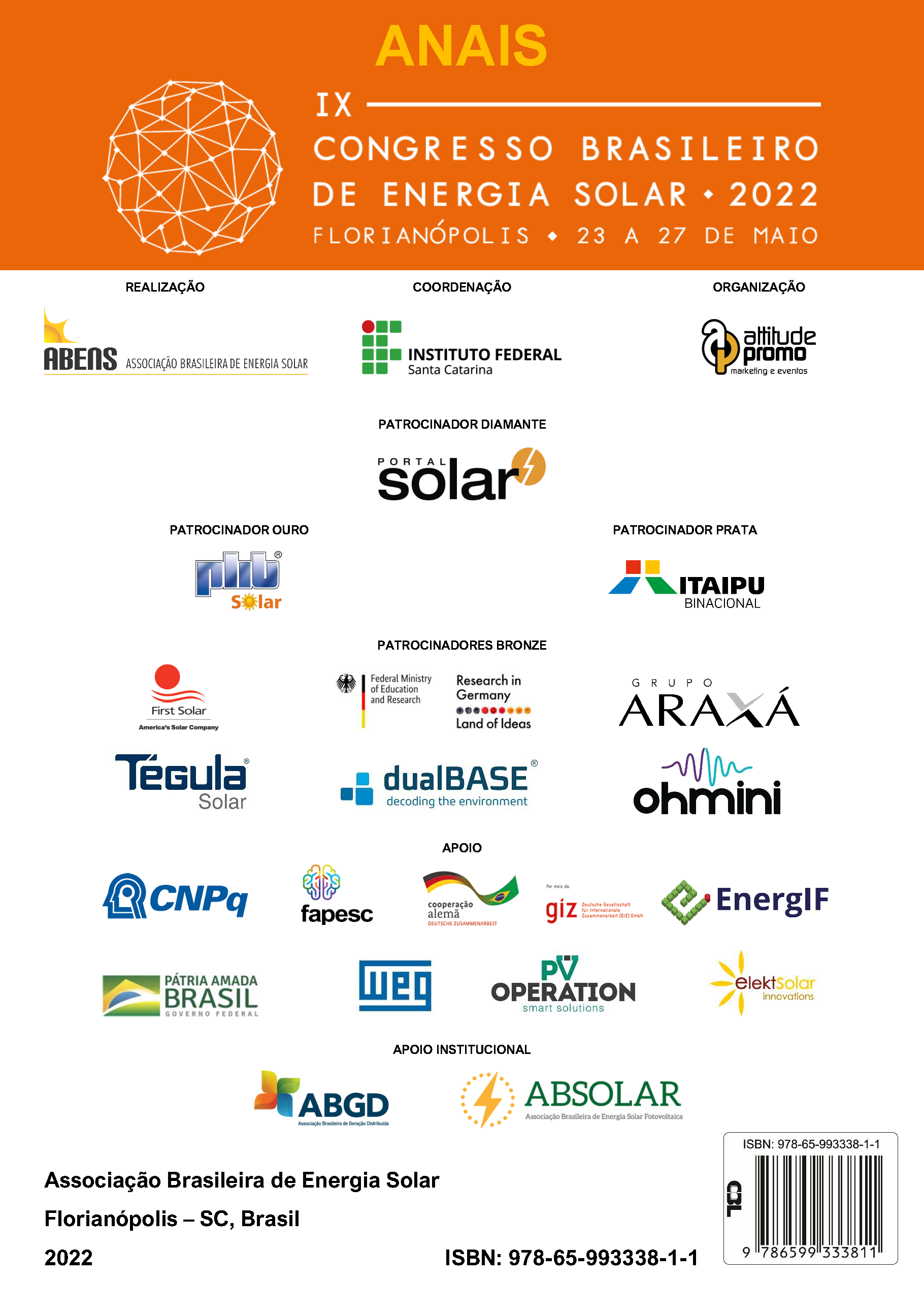USO DE NANOESTRUTURAS DE ÓXIDO DE ZINCO PARA AUMENTO NA EFICIÊNCIA DE CÉLULAS SOLARES ORGÂNICAS
DOI:
https://doi.org/10.59627/cbens.2022.1111Palavras-chave:
Nanopartículas, Óxido de Zinco, Célula Solar OrgânicaResumo
Este trabalho apresenta uma nova abordagem na exploração de nanopartículas (NPs) de óxido de zinco (ZnO), visando melhorar o desempenho de células solares orgânicas (CSO). Nanopartículas de ZnO dispersas na superfície superior da camada ativa da célula podem reduzir a reflexão do dispositivo e aumentar a absorção da radiação solar na camada ativa fotovoltaica, atuando como nanodifusores e introduzindo um aumento de caminho da luz no interior do dispositivo. Neste trabalho é apresentado modelamento óptico e elétrico de células fotovoltaicas orgânicas com a inserção de NPs de ZnO no topo da camada ativa. A contribuição dos nanodifusores de ZnO na melhoria do desempenho das células foi analisada por meio de simulações computacionais, com base no método de elementos finitos. Os resultados mostram que o uso de NPs de ZnO (160 nm de diâmetro) na superfície superior da camada ativa de uma célula solar orgânica pode reduzir a reflectância do dispositivo em até 95 % para λ = 530 nm, promovendo um acoplamento de luz eficiente na camada ativa da célula e simultaneamente aumentando a absorbância (26 %) do dispositivo. Verificou-se também que as contribuições de “light trapping” e efeito anti-reflexo melhoram a geração de fotocorrente, apresentando aumento na densidade de corrente de curto-circuito.
Downloads
Referências
Notarianni, M., Vernona, K., Chou, A., Aljadab, M., Liu, J., Motta, N., 2013. Plasmonic effect of gold nanoparticles in organic solar cells. Solar Energy 106, 23-37.
NREL, Best Research Cell Efficiencies https://www.nrel.gov/pv/assets/images/efficiency-chart.png> (Acesso em 09.12.21).
Park, S., Tark, S. J., Lee, J. S., Lim, H., Kim, D., 2009. Effects of intrinsic ZnO buffer layer based on P3HT/PCBM organic solar cells with Al-doped ZnO electrode. Solar Energy Materials and Solar Cells, 93, 6–7, 1020-1023.
Phornano, Verdequant, Zinc Oxide. <https://www.phornano.com/verdequant> (Acesso em 15.05.21).
Piccinno, F., Gottschalk, F., Seeger, S., Nowack, B., 2012. Industrial production quantities and uses of ten engineered nanomaterials in Europe and the world. J Nanopart Res 14, 1109.
Pillai, S., Catchpole, K. R., Trupke, T., Green, M. A., 2007. Surface plasmon enhanced silicon solar cells. Journal of Applied Physics 101, 093105.
Ramya, M., Nideep, T.K., Nampoori, V.P.N., Kailasnath, M., 2021. The impact of ZnO nanoparticle size on the performance of photoanodes in DSSC and QDSSC: a comparative study. J Mater Sci: Mater Electron 32, 3167–3179.
Reynaud, C., Clerc, R., Lechene, P., Hebert, M., Cazier, A., Arias, A., 2019. Evaluation of indoor photovoltaic power production under directional and diffuse lighting conditions, Solar Energy Materials and Solar Cells, 200, 110010.
Rodrigues, E.S., Silva, M.S., Azevedo, W.M. Feitosa, S., Stingl, A., Farias, P. M. A., 2019. ZnO nanoparticles with tunable bandgap obtained by modified Pechini method. Appl. Phys. A 125, 504.
Scharber, M., Sariciftci, N., 2013. Efficiency of bulk-heterojunction organic solar cells. Progress in polymer Science 38.12, 1929-1940.
Senthilkumar, N., Arulraj, A., Nandhakumar, E., Ganapathy, M., Vimalan, M., Vetha Potheher, I., 2018. Green mediated synthesis of plasmonic nanoparticle (Ag) for antireflection coating in bare mono silicon solar cell. Journal of Materials Science: Materials in Electronics, 29(15), 12744–12753.
Shah, S.K., Khan, J., Ullah, I., Khan, Y., 2017. Optimization of activelayer thickness, top electrode and annealing temperature for polymeric solar cells. AIMS Materials Science 4(3), 789-799.
Shanmugam, N., Pugazhendhi, R., Madurai Elavarasan, R., Kasiviswanathan, P., Das, N., 2020. Anti-Reflective Coating Materials: A Holistic Review from PV Perspective. Energies 13, 2631.
Sharma, S., Tran, A., Nalamasu, O., Dutta, P. S., 2006. Spin-coated ZnO thin films using ZnO nano-colloid. Journal of Elec Materi 35, 1237–1240.
Spyropoulos, G. D., Stylianakis, M. M., Stratakis, E., Kymakis, E., 2012. Organic bulk heterojunction photovoltaic devices with surfactant-free Au nanoparticles embedded in the active layer. Applied Physics Letters 100, 213904.
Srivastava, A., Samajdar, D. P., Sharma, D., 2018. Plasmonic effect of diferente nanoarchitectures in the efficiency enhancement of polymer based solar cells: A review. Solar Energy 173, 905-919.
Stelling, C., Singh, C. R., Karg, M., K¨onig, T. A. F., Thelakkat, M., Retsch, M., 2017. Plasmonic nanomeshes: their ambivalent role as transparent electrodes in organic solar cells, Sci. Rep. 7, 42530.
Stevens, L., Hohn, O., Hanser, M., Tucher, N., Muller, C., Glunz, S., Blasi, B., 2021. Impact of the refractive index on coupling structures for silicon solar cells. J. Photon. Energy 11(2) 027001.
Stingl, A., Silva, M., Alves, V., Ayala, C., Rodrigues, E. Method of Producing a Metal Or Metal Oxide Nanoparticle (WO2021046586). 2021. https://worldwide.espacenet.com/patent/search/family/072355731/ publication/WO2021046586A1?q=phornano
Sun, C., Pan, F., Bin, H., Zhang, J., Xue, L., Qiu, B., Wei, Z., Zhang, Z., Li, Y., 2018. A low cost and high performance polymer donor material for polymer solar cells. Nat Commun 9, 743.
Tress W., 2014. Organic Solar Cells. In: Organic Solar Cells. Springer Series in Materials Science, vol 208. Springer, Cham. p. 139.
Wu, N., Luo, Q., Bao, Z., Lin, J., Li, Y., Ma, C., 2015. Zinc oxide: Conjugated polymer nanocomposite as cathode buffer layer for solution processed inverted organic solar cells. Solar Energy Materials and Solar Cells, 141, 248-259.
Yang, Z., Gao, P., Zhang, C., Li, X., Ye, J., 2016. Scattering effect of the highindex dielectric nanospheres for high performance hydrogenated amorphous silicon thin-film solar cells. Sci. Rep. 6, 30503.
Yu, X., Yu, X., Zhang, J., Zhang, D., Chen, L., Long, Y., 2017. Lighttrapping Al-doped ZnO thin films for organic solar cells. Solar Energy, 153, 96-103.
Zhang, T., Iqbal, S., Zhang, X., Wu, W., Su, D., Zhou, H., 2020. Recent advances in highly efficient organic-silicon hybrid solar cells. Solar Energy Materials and Solar Cells 204, 110245.
Znajdek, K., Sibinski, M., Lisik, Z., Apostoluk, A., Zhu, Y., Masenelli, B., Sedzicki, P., 2017. Zinc oxide nanoparticles for improvement of thin film photovoltaic structures’ efficiency through down shifting conversion. Opto-Electronics Review, 25, 2, 99-102.


